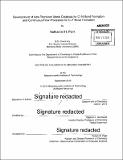Development of new transition metal catalysts for C-N bond formation and continuous flow processes for C-F bond formation
Author(s)
Park, Nathaniel H. (Nathaniel Hamilton)
DownloadFull printable version (33.96Mb)
Other Contributors
Massachusetts Institute of Technology. Department of Chemistry.
Terms of use
Metadata
Show full item recordAbstract
The work presented in this dissertation addresses the development of new methodologies and processes to form carbon-nitrogen (C-N) and carbon-fluorine (C-F) bonds. The development of methods for the formation of C-N and C-F bonds are highly important to chemistry in general and find broad application in many different areas of research. With regard to C-N bond formation, the development of new nickel and palladium catalyst for C-N cross-coupling is presented. Finally, the development of a new process to enable the rapid preparation of aryl fluorides via the Balz-Schiemann reaction is explored. Chapter 1. Development of an Air-Stable Nickel Precatalyst for the Amination of Aryl Chlorides, Sulfamates, Mesylates, and Triflates. A new air-stable nickel precatalyst for C-N cross-coupling is reported. The developed catalyst system displays a greatly improved substrate scope for C-N bond formation to include both a wide range of aryl and heteroaryl electrophiles and aryl, heteroaryl, and alkyl amines. The catalyst system is also compatible with weak base, allowing for the amination of substrates containing base-sensitive functional groups. Chapter 2. Design of New Ligands for the Palladium-Catalyzed Arylation of a- Branched Secondary Amines. In Pd-catalyzed C-N cross-coupling reactions, a-branched secondary amines are difficult coupling partners and often produce low yields of the desired product. To provide a robust method for accessing N-aryl a-branched tertiary amines, new catalysts have been designed to suppress undesired side reactions often encountered when these amine nucleophiles are used. These advances enabled the arylation of a wide array of sterically encumbered amines, highlighting the importance of rational ligand design in facilitating challenging Pd-catalyzed cross-coupling reactions. Chapter 3. Rapid Synthesis of Aryl Fluorides in Continuous Flow via the Balz- Schiemann Reaction. The synthesis of aryl fluorides (ArF) is of critical importance for the development of new and potent pharmaceuticals and agrochemicals. While there have been numerous and intense research efforts focused on developing new fluorination methods, the Balz-Schiemann reaction remains a valuable and efficient means of aryl C-F bond construction from a vast pool of available aryl amines. However, the harsh reaction conditions, modest yields, and often prohibitive safety concerns have limited the general application of this methodology. Here, we have developed a semi-flow process that enables safe handling of the potentially explosive aryl diazonium salt intermediates as well as improved yields of the desired aryl fluoride products. This process has been demonstrated on an array of different aryl and heteroaryl amine substrates containing a variety of different functional groups.
Description
Thesis: Ph. D. in Organic Chemistry, Massachusetts Institute of Technology, Department of Chemistry, 2015. Cataloged from PDF version of thesis. Vita. Includes bibliographical references.
Date issued
2015Department
Massachusetts Institute of Technology. Department of ChemistryPublisher
Massachusetts Institute of Technology
Keywords
Chemistry.